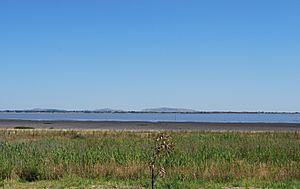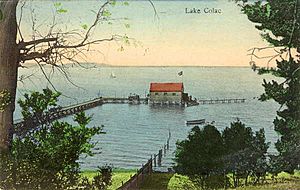Lake Colac facts for kids
Quick facts for kids Lake Colac |
|
|---|---|

Lake Colac with historically low water levels
|
|
| Location | Victoria, Australia |
| Coordinates | 38°18′S 143°35′E / 38.300°S 143.583°E |
| Type | FreshWater |
| Primary inflows | Barongarook Creek |
| Basin countries | Australia |
| Max. width | 1820 hectares |
| Average depth | 2.5 metres |
| Max. depth | 3.0 metres |
| Settlements | Colac |
Lake Colac is a big freshwater lake in western Victoria, Australia. The town of Colac is right next to its southern shore. This lake is huge, covering 1,820 hectares. It's about 2.5 metres deep on average and has a shoreline of 33 kilometres.
Long ago, the Kolijon (or Coladjin) people lived here. The name Colac might come from their name. It could also come from their word kolak, which means the lake's sand or fresh water.
Contents
Fun Things to Do at Lake Colac
Lake Colac is a great spot for watersports! You can enjoy sailing, rowing, and water skiing here. The area along the lake's edge is called the foreshore. It has a fun playground and a boat ramp for launching boats. The beautiful Colac Botanical Gardens are also right next to the lake.
Why Lake Colac's Water Level Changes
Water flows into Lake Colac from Barongarook Creek. However, the lake usually loses more water than it gains. This happens because of evaporation, which is when water turns into vapour and goes into the air. For the lake to stay full, it needs a lot of rain to fall directly over it.
In January 2009, something unusual happened. After many years of dry weather, the lake completely dried up. This shows how much Lake Colac depends on rainfall to keep its water levels high.
Keeping Lake Colac Clean
The water quality in Lake Colac is sometimes low. This is because of things called nutrients that get into the lake. Nutrients are like food for plants, but too many can cause problems. Examples of these nutrients are phosphorous and nitrogen.
These nutrients often come from farms and untreated waste water. Chemicals and rubbish from the town of Colac have also entered the lake. When there are too many nutrients, a type of tiny plant called blue-green algae can grow very fast. This algae can make the water unsafe for people and animals.
People have been working hard to make the lake cleaner. They are trying to stop these nutrients from getting into the water. This helps keep the lake healthy for everyone.
Fish in Lake Colac
Lake Colac is home to several types of fish. You can find redfin, eels, and carp swimming in its waters. In 2013, there was a plan to add another type of fish to the lake. The idea was to introduce estuary perch, which would add to the variety of fish living there.
Images for kids



